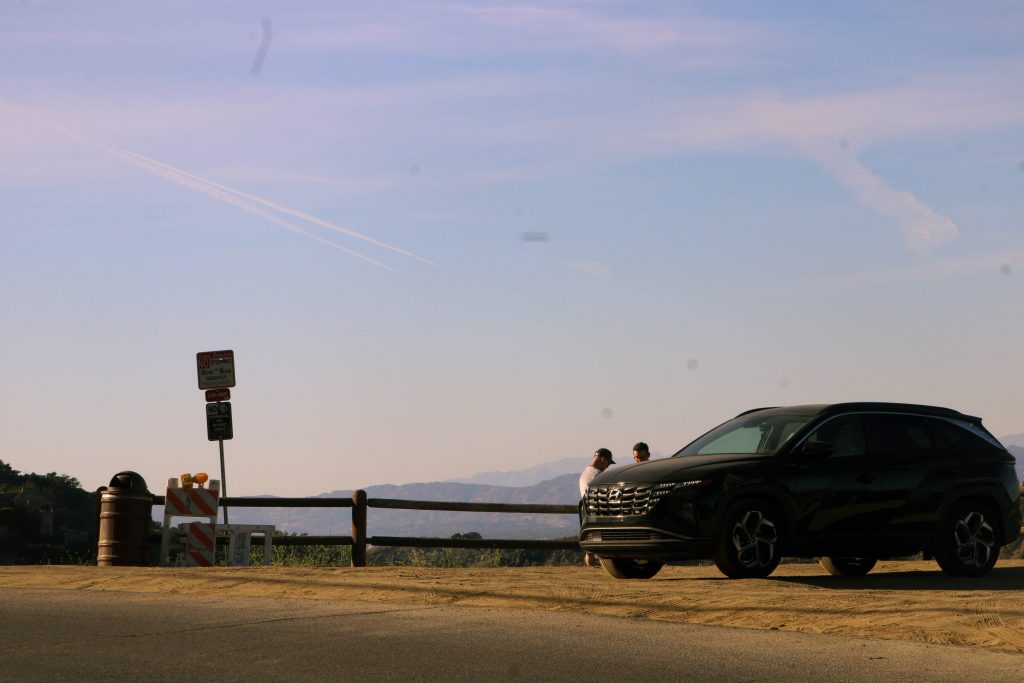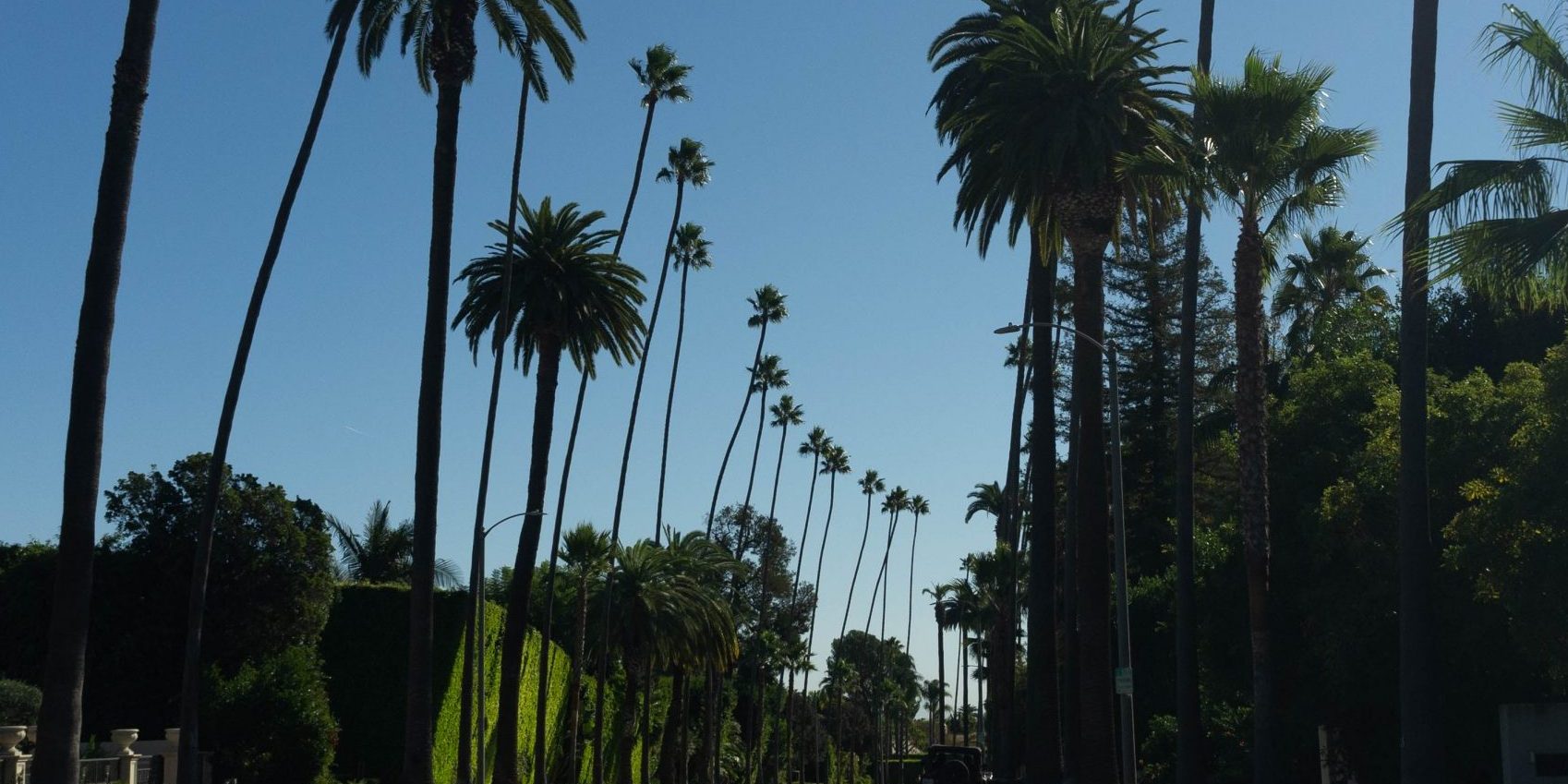It was a slow Sunday morning in Los Angeles. The sun overslept, yawned hot air and its haze sprawled from the desert, crawled around the mountains to swallow the sea shore. Cloudless blue skies bleached the fabric of the city. Glass skyscrapers, pueblo bungalows, Bauhaus mansions, googie apartments all were starched and flattened into earthy, coastal pastels.
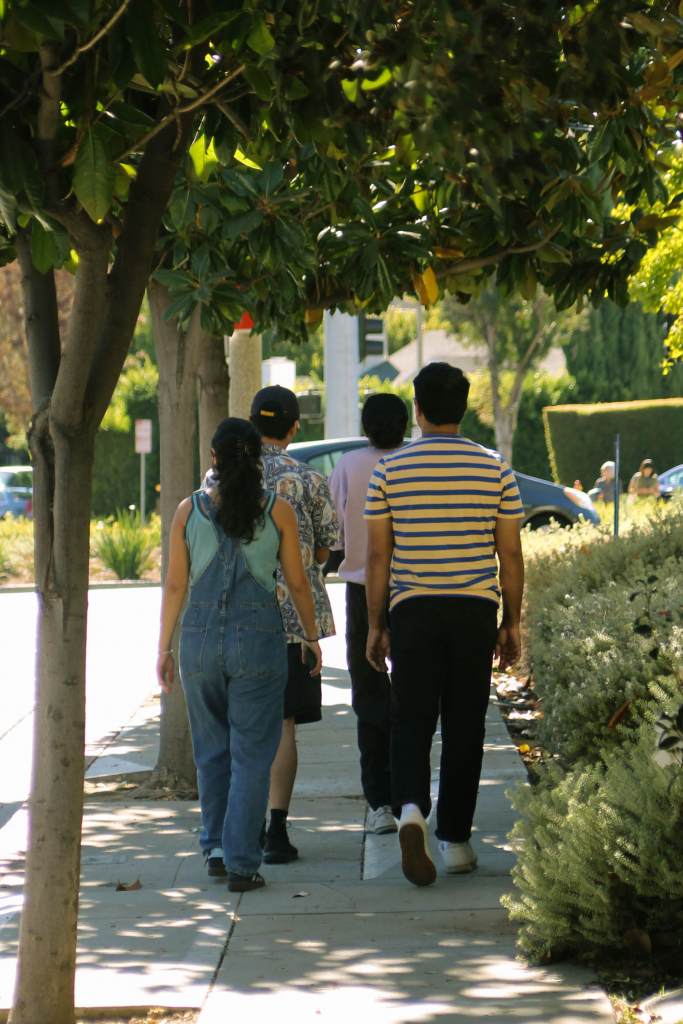
On the corner of Gayley and Strathmore in Westwood, just outside the UCLA campus, Lily and Ethan waited patiently for the gang to come together. Ethan under a dark navy baseball cap and Lily with a camera. Their plan was to cut open the city, reach into the belly of Los Angeles; observe its diverse, gregarious characters and attempt to weave them together with its cultural cache. It’s a haven for migrants, gourmands, and dreamers that’s been creatively, chaotically, chopped up into passive B-roll footage, artificial studio lots, and glamorous pop lyrics.
First, in a battered white hatchback, Zain hung a left from Gayley and parked with a screech in front of Lily and Ethan. He was unrecognizable with his mustache. Within a few minutes, Grace emerged from the east in denim overalls. Kanchan descended down the hill from the west in a Nike sweatshirt with a lilac blush. All together, they gathered into the ride, chatting over the endless number of songs that mention Los Angeles.
Beverly Hills Farmers Market
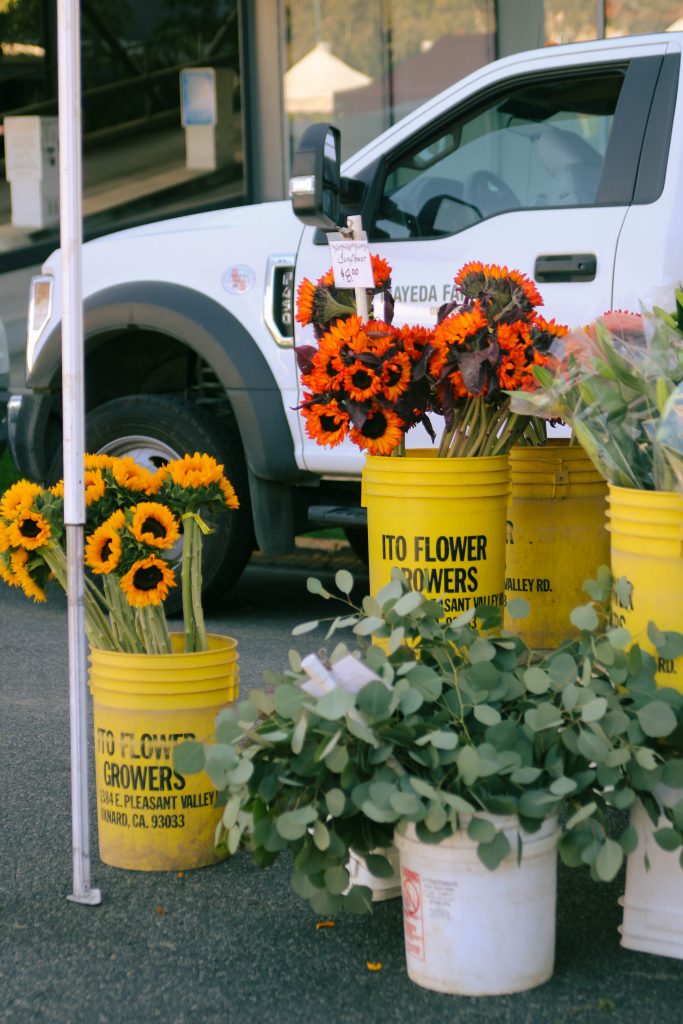
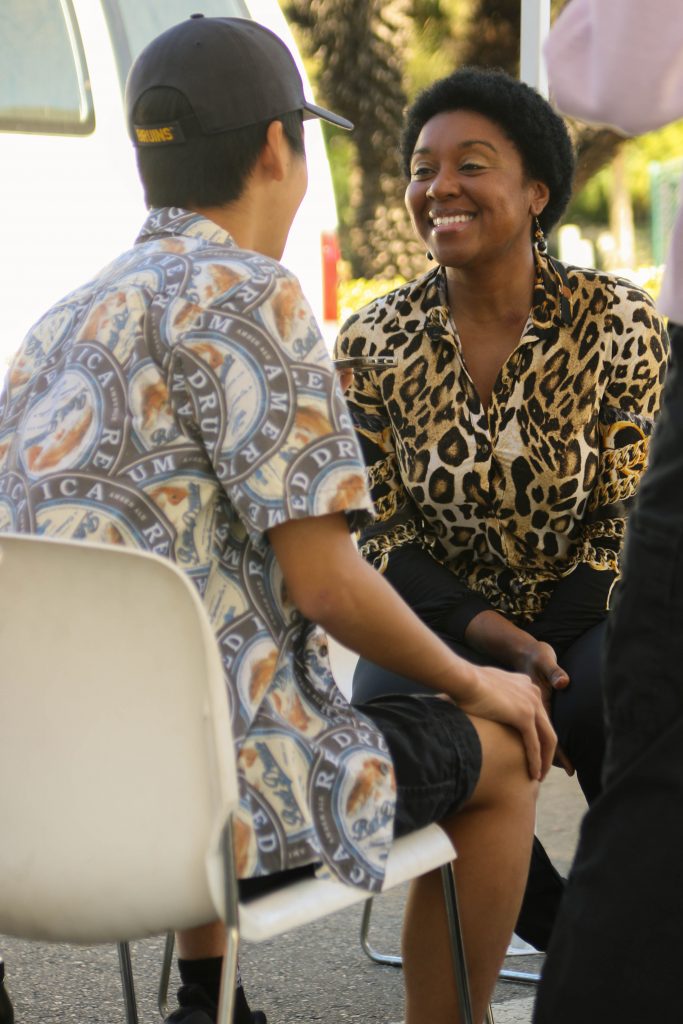
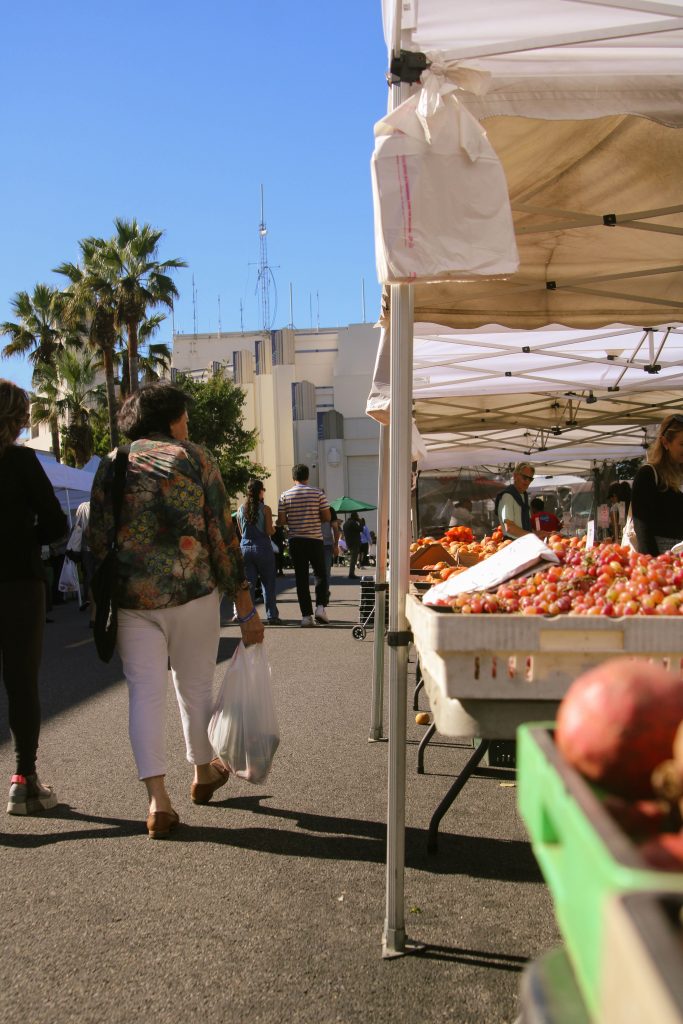
The drive to Beverly Hills was like a movie montage: big gated houses, fifteen foot hedges, and tall skinny palm trees on either side of the boulevard. Off Santa Monica, behind city hall, is the Beverly Hills Farmers Market. White vinyl tents were lined up along the two curbs of Civic Center Drive. They were a geometric abstraction of the green Transverse Ranges on the horizon. The scene was populated by a coffee truck, handmade soaps, fresh made bread, tamales, orchids, cheesemongers, fishmongers, organic greengrocers, homemade pasta, babaganoush, juicers, Korean Barbecue, along with a petting zoo which contained adorable calves, kids, chickens, and piglets.
As soon as he entered the market, Ethan took note of the music blaring off a set of giant speakers at an ecstatic volume. Under one of the blanched tents, a woman in a leopard print blouse played reggaeton standards on her electric violin. It was clear from her smile and her poise that she understood the city, and its working relationship to music better than most. When she took a break, Ethan approached her. Grace, Kanchan, and Zain joined in to say hello. Lily took some portraits. Serendipitously, Sheryl Crow’s “All I Wanna Do” played in the background where, over and over again, she sings, “Until the sun comes up over Santa Monica Boulevard …”
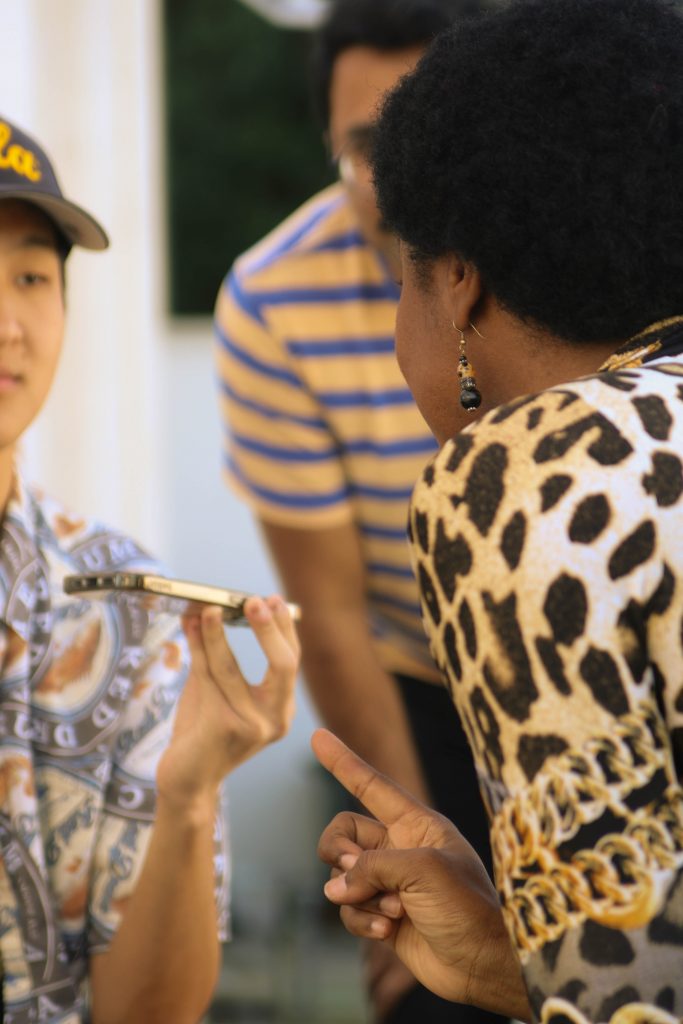
Her name is Dayren Santamaria, and the first thing she told them was that she is from Cuba. “I was born in Cuba, in a city called Matanzas, and when I was eight years old I started to study violin. I played for the symphony orchestra, that was my first job, and we were touring all over the world—we were performing—and we came to Los Angeles in 2001. Then I went back to Cuba. And when we came back in 2002, I defected. I started a new life here.”
“From 2002, I lived in Florida and I did my Master’s there at the University of South Florida. And in 2007 I moved to Los Angeles. So, I’ve been here since 2007 and now I have my own band, and I play with other people as well.”
Ethan asked, “How did you get into the public performance aspect of playing the violin?”
“I’ve always been a musician and you always have to play everywhere, right? But I played classical music … and after I graduated, I said, ‘I want to explore more.’”
“Since I’m from Cuba, I love Cuban music, so I started playing Cuban music. I started playing Latin Jazz, and now I play everything—anything!”
It was clear from her conversation with Ethan that Dayren is very passionate about the livelihood of musicians—especially in Los Angeles. She said, “I would love to be more involved in so many things. There are so many musicians that, even after the pandemic, maybe are performing a lot but there are many others who are not performing enough. So I’m moving around anywhere, apart from LA because LA is so expensive. But there are so many other ways that the city, and LAUSD, and many other programs and institutions here can involve more musicians—but they don’t do it.
“For example, with LAUSD, there are so many musicians they can bring to the schools to interact a bit more with the students and to give them more of a connection. Some of them [the students] are learning music, but they’re not very passionate in the way that they learn it. It’s very minimal, very basic, and it should be enforced to bring in musicians to build a connection.”
“That’s true,” confessed Ethan, “because when I was in school, when we had music class, it was just playing recorders. I feel that wasn’t as interactive as it could have been.”
“Yeah!” Dayren agreed sympathetically. “And it would be nicer if they would bring some kind of musicians … professional musicians once a week, or something, to the school so you could see and then maybe take some lessons. It would help the music community a lot more.
“Even if they [the students] are not going to be professional musicians in the future, it’s okay. Because they will have that culture since they’re little. And at the same time you’re helping artists.”
“What would you say is something special about the music scene here in LA?” Ethan then asked.
“Everything is special!” Dayren responded. “There are so many people from many different places. What we’ve got here is so diverse: the community, music artists, everything. It’s diverse and that’s the thing that’s lovely about LA.”
“But it’s very expensive. That’s why many artists go away too. Because they can’t afford it at some point. But we keep trying, we keep trying …”
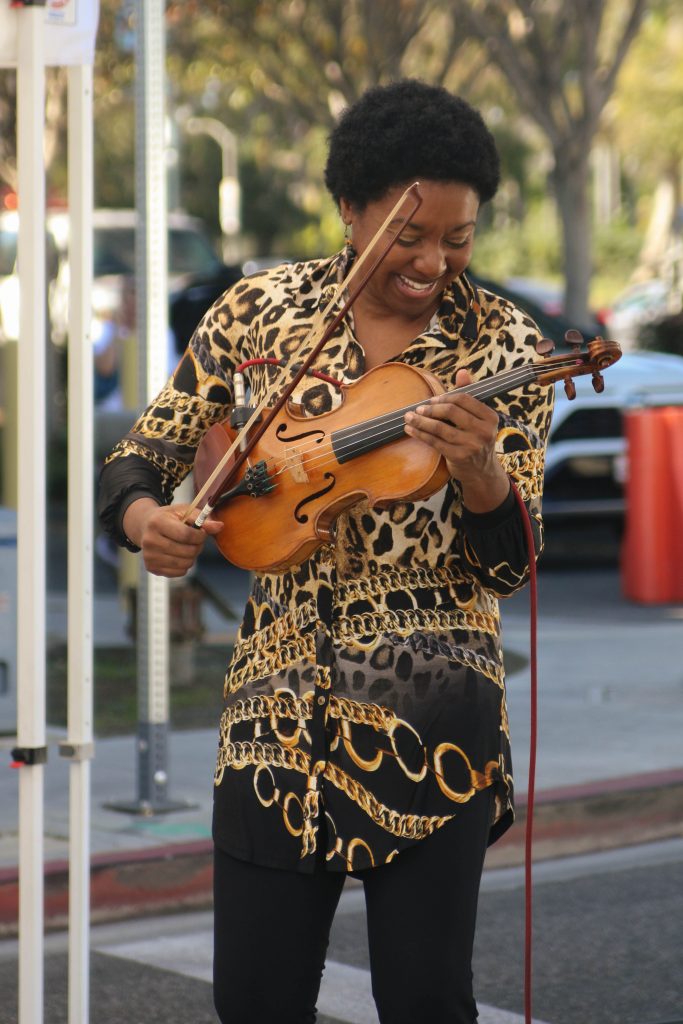
Before the group parted with Dayren, Ethan had one last burning question for her: “On their song ‘Beverly Hills,’ Weezer sings, ‘Beverly Hills, that’s where I want to be [gimme gimme, gimme gimme].’ Do you agree or disagree with that statement?”
“Of course!” Dayren answers, enthusiastically. “Of course, Beverly Hills is super cool. It’s super nice. What they should do is put the quality of life, the beauty of the streets—it should be all around Los Angeles. Just the cleanliness of the streets and the coolness of the buildings, that should be all over Los Angeles. Because it’s not. Everyone comes here and it’s so nice. Do you understand what I’m saying? You feel great, greater, by being here. And that should be instituted in many other places, so many other places.”
“Los Angeles has a lot of resources to rebuild a lot of neighborhoods that are not very nice. So, I think if they were to rebuild many other neighborhoods, it would be so much nicer. Bring some music, bring some excitement, some nice restaurants—it would be so nice.”
Dayren is the prototypical Angelena. As an immigrant and a musician, her life in the city and her dynamic relationship to the city reveal both the cracks and the beauty of Los Angeles. It’s a place that’s attractive in quality and welcoming with its diversity. Yet, on the other hand, it’s also a place that’s defined by inequality and is systemically hostile to working artists. The paradox of Los Angeles is that it’s so clearly a utopia, as Weezer sings, a cultural power, but it’s exclusive to the filthy rich. There is a disconnect between its image and most of its people.
One day, perhaps artists like Dayren, with their work and vision, can transform the city so that every stripmall, freeway overpass, and car wash can feel like Beverly Hills.
Cartier, Rodeo Drive
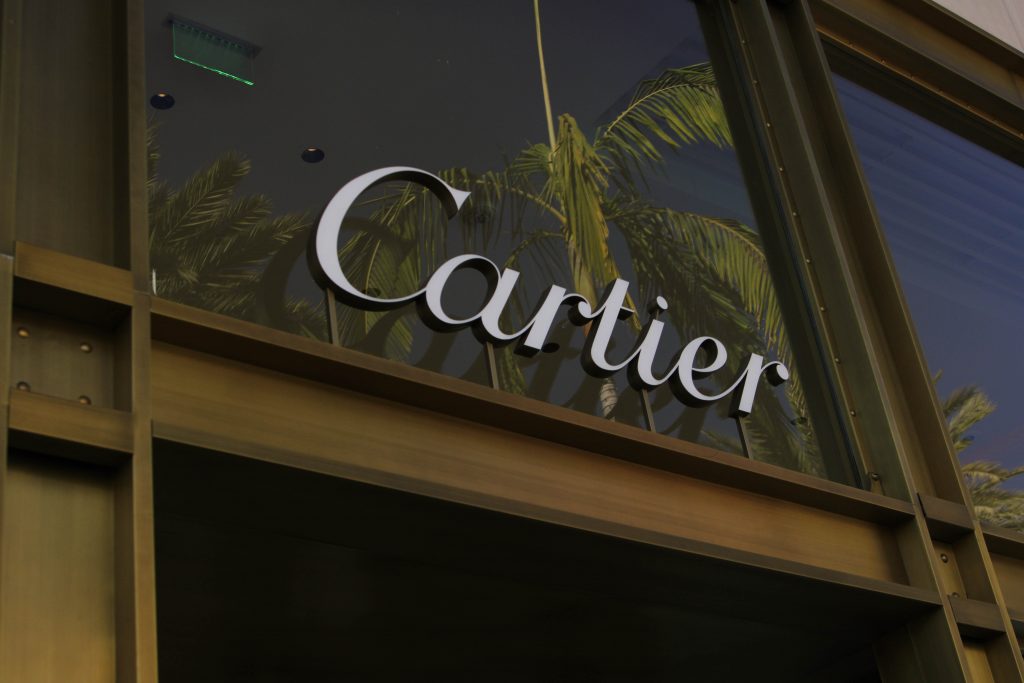
Four blocks west of the farmers market, Beverly Hills transforms from a pristine neighborhood into a polished, posh version of Disneyland’s Main Street. Rodeo Drive. It’s all façade, faux Italianate architecture sandwiched between glossy shop windows with mannequins in unaffordable leather fits. Palm trees and bespoke luxury cars ornamented the sidewalks. Stores like Fendi, Hermés, Rolex, Balenciaga, Gucci, and Louis Vuitton climaxed at an epic Christmas tree near Via Rodeo where tourists from all over the globe posed for photographs. Nowhere else in the city is more emblematic or antithetical to Los Angeles than this strip, angled at forty-five degrees, between Santa Monica and Wilshire Boulevards.
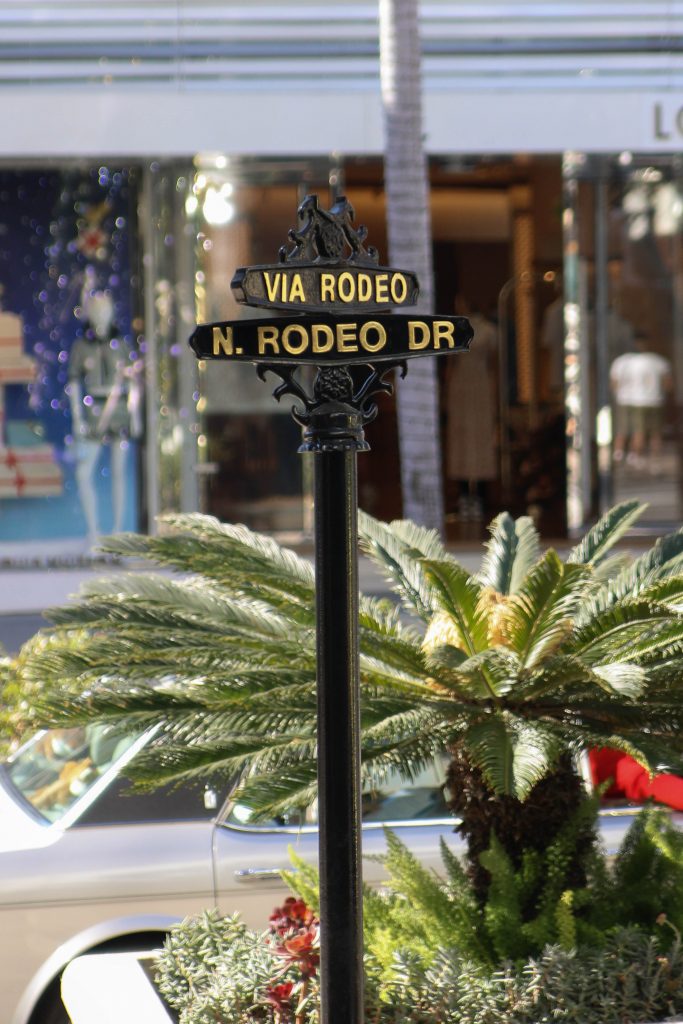
Some of these high-end stores are manned by security, tailored in black suits with earpieces on the side of their heads. Zain had the idea to interview a guard on Rodeo Drive, partially because it would be funny and partially because they could provide some grounded insight into this otherwise highfalutin place. They are a bit more salt of the earth than the customers and clerks, and though they seem like gatekeepers, the security in front of these often gold framed doors are a welcome bridge between what’s public and what’s exclusive. From the corner of Brighton Way and Rodeo Drive, Zain spotted a man in white gloves, behind a stanchion of red velvet rope under a large gold sign that elegantly read Cartier. Ethan approached him for a conversation. The security guard quickly opted for anonymity.
“I’m from South Central.” He said. When asked about his position at the store, the security guard nonchalantly answered, “It’s just a job. Just trying to find the most chill thing to do for the highest pay.”
Since he works at one of the most famous streets in the world, Ethan asked him if he’s ever seen any famous people around. “Justin Bieber …” He said, immediately off the top of his head. “… Travis Scott. Timothée Chalamet was here, like, last week.”
While such name drops were likely expected, it still elicited a sense of glee from Grace, Kanchan, Lily, and Zain. Ethan, to cap off the conversation, looked up and down the street then asked the security guard: “Billy Ray Cyrus, in the Lil’ Nas X song ‘Old Town Road’ sings, ‘Ridin’ down Rodeo in my Maserati sports car.’ How many Maseratis do you see while you’re out here working?”
“Oh,” responded the guard, without a moment of hesitation, “I see a Maserati once every ten minutes.”
Chateau Marmont
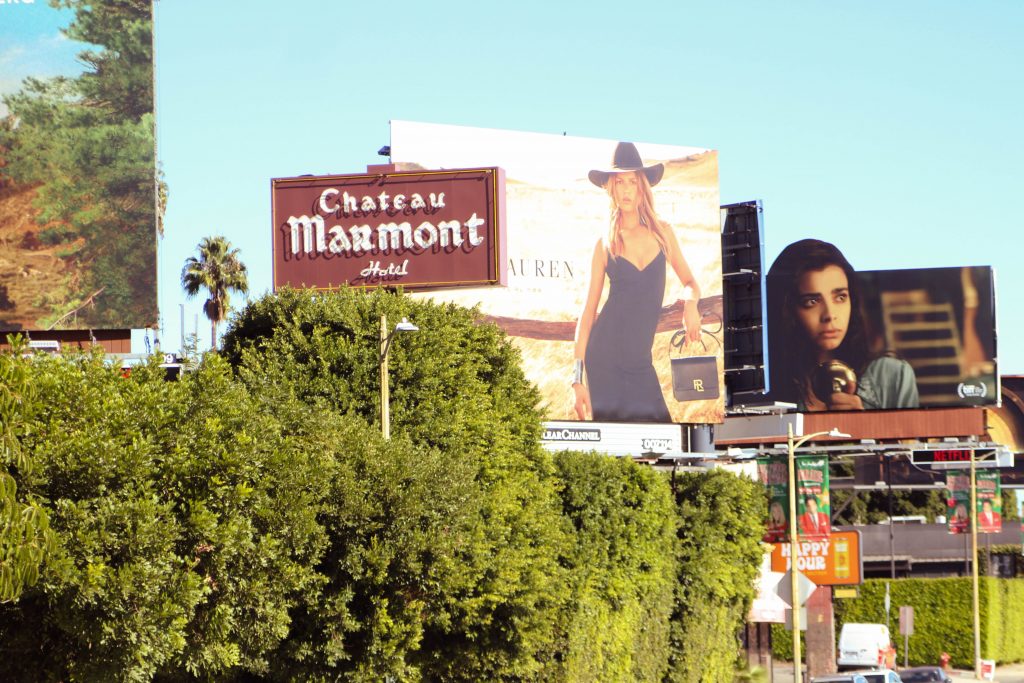
Tucked behind the gazes of all the photogenic models on the endless billboards along Sunset Boulevard, eastbound toward Hollywood, is the notorious Chateau Marmont. Within its pointy, nouveau gothic exterior lies the magical origin of some of Tinseltown’s most salacious myths. Built in 1929, the hotel has been host to a series of binges, mishaps, affairs, and bursts of creative energy. Its reputation stands on the delicate privacy offered by the establishment, despite the notable history that haunts Chateau Marmont’s sixty-three rooms. A diverse list of people are associated with the hotel: James Dean, Heath Ledger, Greta Garbo, Britney Spears, F. Scott Fitzgerald, John Bonham, Lindsay Lohan, Natalie Wood, Nathanael West, Death Grips, Howard Hughes, Jim Morrison, Jean Harlow, Clark Gable, Elizabeth Taylor, Claes Oldenburg, Montgomery Clift, Dennis Hopper, Courtney Love, John Frusciante, and John Belushi; just to name a few. They’ve all eaten, fucked, or died at the Chateau Marmont. The legendary lodge seeps into ears and eyes as well. Sophia Coppola’s Somewhere takes place inside the establishment. Both Lana Del Rey and Father John Misty have featured it in their songs. Jarvis Cocker and Chilly Gonzalez recorded an entire album devoted to a single room of the hotel—number twenty-nine.
Zain parked the hatchback on the upward slope of Kings Road, and everyone walked down Sunset past Saddleranch, Doughbricks, Carney’s, and Pink to casually enter the mezzanine of the hotel. The garage was chock full of antique cars and Teslas alike. A bronze elevator looked like it was manually operated, and the warm light gave life to the maroon carpet which led Kanchan, Grace, Lily, Ethan, and Zain up the mahogany staircase to the lobby. They were greeted by an empty bar and a sitting room furnished with velvet loveseats, armchairs, and barstools. The ceiling had curved, rod iron chandeliers with teardrop bulbs. Meanwhile the walls were decorated with sconces and lit candles that quietly maintained the mood. Thick curtains darkened the space, which otherwise had plenty of windows that looked out either into hedges or a patio with a covered dining space. There was a shiny grand piano with a lamp topped by a cloth shade ornamented with tassels. Kanchan sat down on one of the loveseats, next to which was an end table with a box full of records. Ethan picked through the collection and pulled out Nightclubbing by Grace Jones. Overhead, the speakers played indie music from the 2000’s and 2010’s.
Lily perused around the space and took photos. She was quickly shunned by the concierge. There was no one in the lobby to engage with about music. A few blonde people lined up at the front desk, dressed in boho chic attire with pencil thin tattoos up and down their arms. There was one softly dressed boomer who sat in the corner, but his head was buried in his black ASUS laptop. Everyone and everything looked and felt exclusive. So Kanchan, Grace, Lily, Ethan, and Zain just hung around and opened themselves up to the general vibe of Chateau Marmont with the hopes that someone approachable would come down. The concierge immediately sniffed out this aimless leisure in the group and with severe shortness told them to leave. As if this was the worst thing to ever happen inside this hotel.
Formosa Cafe
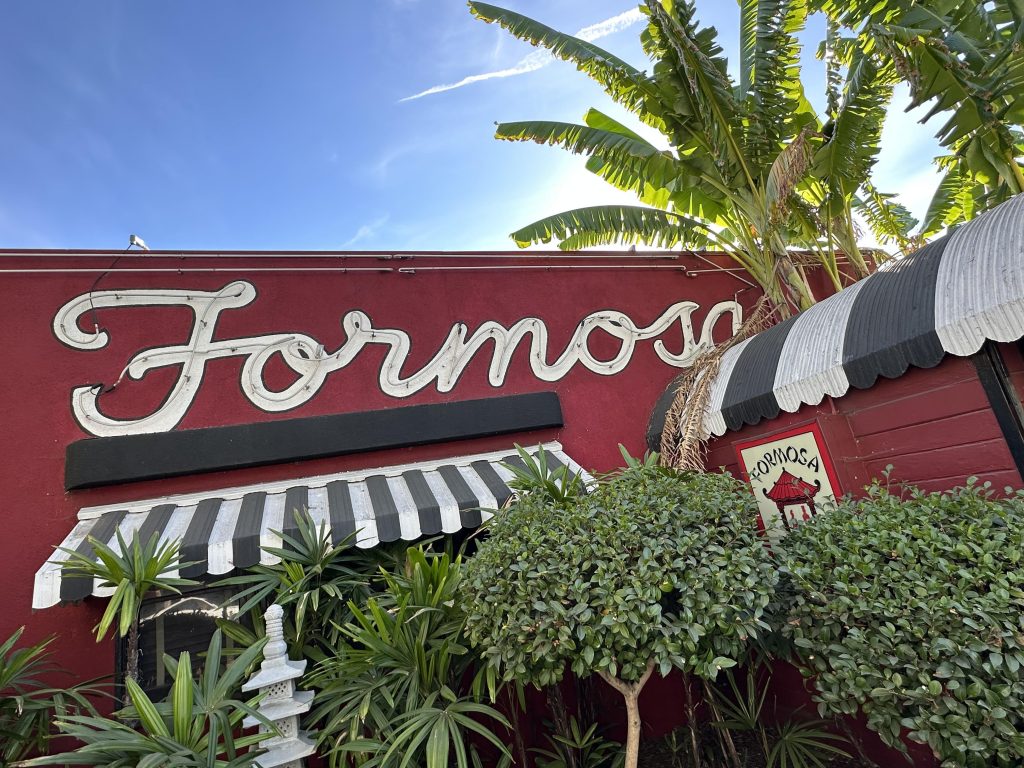
“Have you ever heard of the Formosa Cafe?” Grace asked the rest of the group. “Apparently Elvis Presley wrote some of his songs there.” The destination had an air of mystery for Kanchan, Ethan, Lily, and Zain, but Grace’s high-key iconic reference, paired with a collective hankering for lunch, made the restaurant an ideal stop. They drove eastbound on Santa Monica Boulevard, in the pits of Hollywood, and parked underground in a complex made up of Target, Best Buy, BevMo!, Verizon, Mendocino Farms, GNC, Ulta, and Supercuts. The classic eatery shares a lot with the basic mall, where it stood out with its rouge exterior, green neon sign, striped awning, and tropical landscaping. The modest, rectangular, two story structure was finished in 1939 and features an annexed red trolley car which dates back to 1904.
Inside, the cafe was a mood from another moment in history, an entirely different time. Everything was red, lit by dim, dusty light through the narrow slits of dark venetian blinds and opaque lanterns with red tassels. The black terrazzo floor was identical to the sidewalks of the Hollywood Walk of Fame. There was a large bar in the middle of the space, and red leather booths along the walls, which were covered with red velvet wallpaper. One of the booths is dedicated to the “King of Rock & Roll,” with an effigy mounted above the back seats that contains various memorabilia and action figures. It was Elvis’s preferred spot to eat. Another booth, on the other side of the restaurant, belonged to noted mobster Bugsy Seigel and it was where he hung out with his gangland crew. The trolley contained small tables on dark brown hardwood floors, which had a distinct glow from a series of large, round Edison bulbs. Buddhist and Taoist statues eternally man the establishment. Headshots of old Hollywood glory border the entire place. Faces like Robert Mitchum, Sidney Poitier, James Dean, Marilyn Monroe, Frank Sinatra, Anna Mae Wong, Dean Martin, Charles Bronson, Jack Webb, Ricardo Montalban, Dana Andrews, and Jean-Pierre Cassel—many of them dedicated to staff with an autograph. The back, southern end of the Formosa Cafe is devoted to Asian American performers, with headshots of classic, many forgotten, Asian American actors and posters of movies which featured Asian American cast or crew. The speakers played classics like “You Make Me Feel So Young” by Frank Sinatra and “Take The A Train” by Duke Ellington. On the second level, the cafe hosts screenings of old movies.
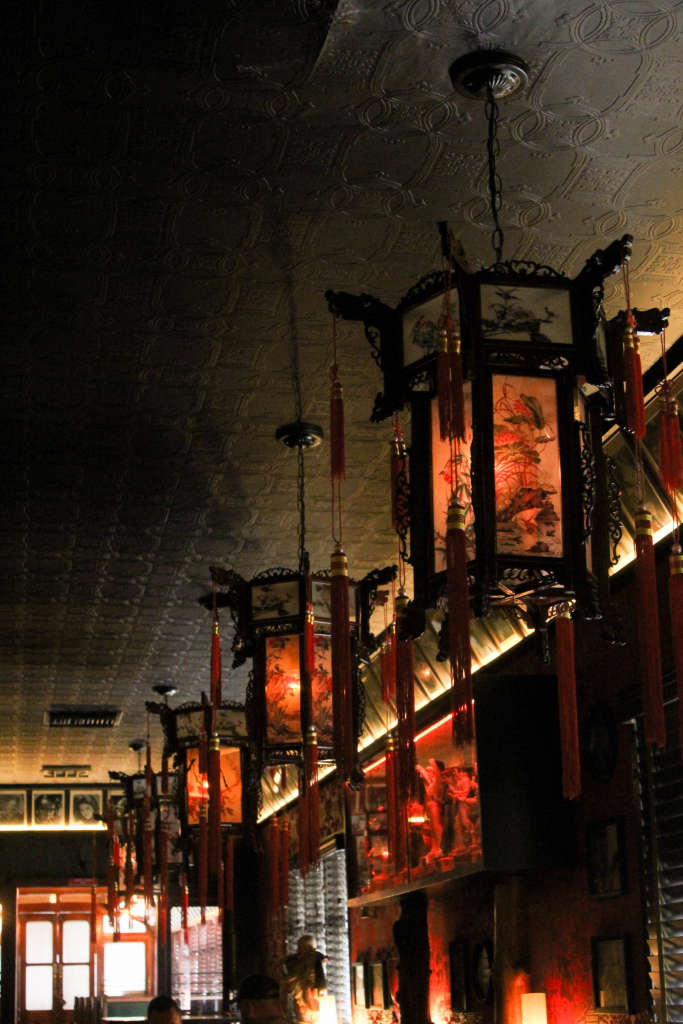
Grace and company were welcomed by Sandy, a hostess in a gray bob with encyclopedic knowledge of the restaurant and the city. She was hospitable and all business at first. Ethan ordered pork belly gua bao, Kanchan ordered scallion pancakes, Grace ordered coffee, Lily ordered a cucumber elixir, and Zain ordered apple cinnamon wontons served with vanilla ice cream. After the food was served, Grace flagged Sandy and asked her if she knew anything about the history of Formosa Cafe. “This is the second oldest restaurant in Hollywood,” Sandy said, “and it was where all the stars and wannabe stars came. Mostly because across the street, there was a lot where many classic movies were shot.” Currently, that space is made up mostly of offices, though a few lots remain. “This booth that you’re sitting in was John Wayne’s booth.” She told them. “Legend has it that one night he got so drunk that he passed out on the booth and the waitstaff just left him to sleep overnight. When the cooks came in the next morning, they found him cooking eggs in the kitchen.”
All of Los Angeles can be found in Sandy’s head. She told Grace that before hospitality, she used to work at MGM studios and specialized in film history. Her passion lies in movies from the 1930’s and her favorite catalog belongs to Warner Brothers. To her, the best movie about Los Angeles is Chinatown, as it’s written by born and bred Angeleno Robert Towne. Her two favorite songs are “LA Woman” by The Doors, who she mentioned went to UCLA film school, and “I Love LA” by Randy Newman.
When asked about any other stories that concern Hollywood royalty, Sandy shrugged and informed them, “Ninety percent of the photos here are of people who actually dined in the restaurant.” Of course, she pointed to the Elvis and the Bugsy booths. Then she mentioned a more recent happening, “This year, in January, after the Golden Globes, the cast and crew of Baz Luhrmann’s Elvis rented out the entire place to celebrate. Lisa Marie Presley was here. Forty-eight hours later she died.”
This last detail spooked everyone out. Sandy then informed them of another haunting. “There’s a ghost or a poltergeist here,” she said. “One night, we were supposed to screen a Rock Hudson movie. For some reason, I don’t know why, we canceled it and mysteriously Rock Hudson’s headshot, above the bar, fell straight to the ground. Stuff like that happens all the time.”
After they finished their lunch, Grace, Lily, Kanchan, Ethan, and Zain received fortune cookies with ominous premonitions inside. Fortunately, none of them died in the following forty-eight hours.
Mulholland Drive
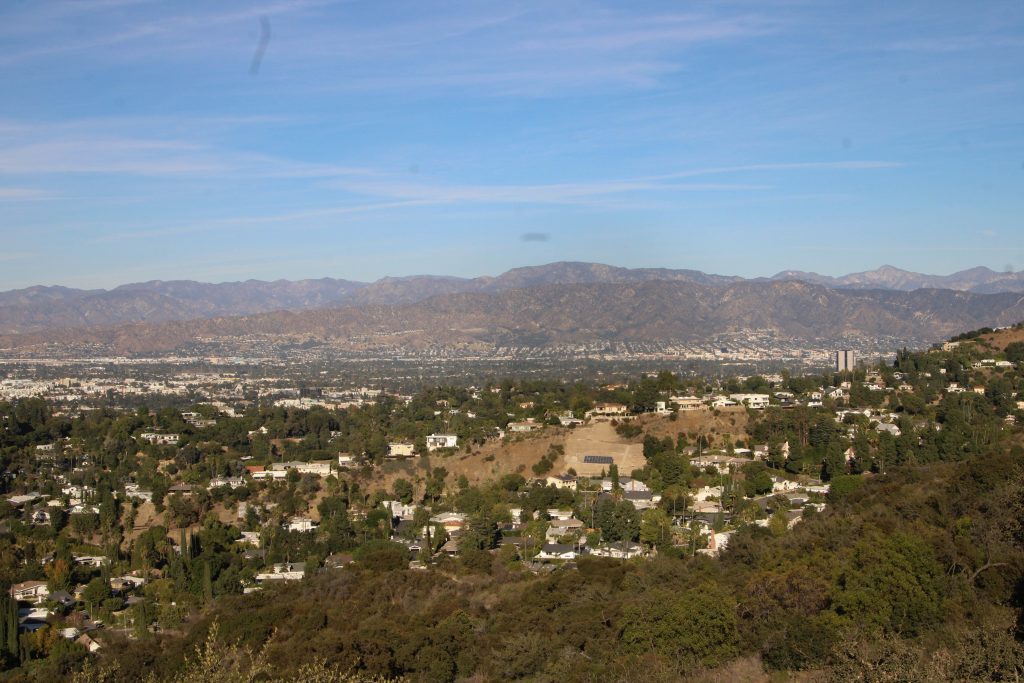
It’s not uncommon for out-of-towners to get starstruck over a road in Los Angeles. For beginners there is Billy Wilder’s 1950 classic Sunset Boulevard, the 1990’s primetime soap Melrose Place, and the contemporary disaster series La Brea. In a city full of famous streets, boulevards, and avenues, there’s likely no more scenic a route than Mulholland Drive. Of course, there is a movie named after the windy road from the city to the valley—past Joni Mitchell’s Laurel Canyon. The 2001 David Lynch feature starring Naomi Watts is an uncompromising queer nightmare that tears apart the veneer of Hollywood to reveal the traumas at the center of the very same dreams which invite artists, actors, and performers to make it big in Los Angeles. On the surface, Mulholland Drive is a pleasant and picturesque trip taken to catch views of Malibu or the vast suburbs. But the mountainous trek can be a source of real fear, as Kanye West raps in “No More Parties in LA”: “I be thinkin’ every day / Mulholland Drive need to put up some god damn barricades / I be paranoid every time, the pressure.”
Matt, in a blue and white striped shirt, and Alex, with a black and white trucker hat, both agree. “Yeah, Mulholland Drive needs more barricades,” they told Kanchan. The two Canadians from Calgary made it a point to pass through the famous road while on a trip in Southern California to visit family in Irvine. With the gaping San Fernando Valley behind them, surrounded by rolling peaks carpeted over with endemic chaparral, Alex reflected on the similarities between Los Angeles and Canada. “It kind of reminds me of Toronto,” he said. This surprised Kanchan, Grace, Zain, Lily, and Ethan. “They’re both very crowded and there’s a lot of traffic.”
More and more Hollywood productions are shot in Canada. Last year the industry clocked in 171 movies and TV shows that were filmed up north. Perhaps sometime in the future, a hundred years or so from now, tourists will flock to Dundas, Coxwell, and Danforth to immerse themselves in recognizable Hollywood scenes. Tinseltown has branched out of Los Angeles and has begun to colonize the world. The nightmares of Mulholland Drive are now everywhere.
